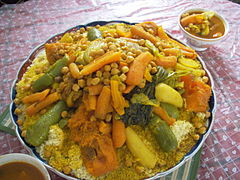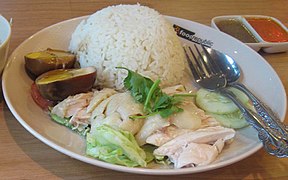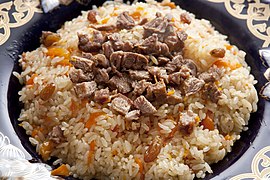A national dish is a culinary dish that is strongly associated with a particular country.[1] A dish can be considered a national dish for a variety of reasons:
- It is a staple food, made from a selection of locally available foodstuffs that can be prepared in a distinctive way, such as fruits de mer, served along the west coast of France.[1]
- It contains a particular ingredient that is produced locally, such as a paprika grown in the European Pyrenees.[1]
- It is served as a festive culinary tradition that forms part of a cultural heritage—for example, barbecues at summer camp or fondue at dinner parties—or as part of a religious practice, such as Korban Pesach or Iftar celebrations.[1]
- It has been promoted as a national dish, by the country itself, such as the promotion of fondue as a national dish of Switzerland by the Swiss Cheese Union (Schweizerische Käseunion) in the 1930s.
National dishes are part of a nation's identity and self-image.[2] During the age of European empire-building, nations would develop a national cuisine to distinguish themselves from their rivals.[3]
Some countries such as Mexico, China or India, because of their diverse ethnic populations, cultures, and cuisines, do not have a single national dish, even unofficially.[2] Furthermore, because national dishes are so interwoven into a nation's sense of identity, strong emotions and conflicts can arise when trying to choose a country's national dish.
Latin American dishes
In Latin America, dishes may be claimed or designated as a plato nacional,[4] although in many cases, recipes transcend national borders with only minor variations.[citation needed] Preparations of ceviche are endemic in Peru and Ecuador, while a thin cut of beef known as matambre is considered close to being a national dish in Paraguay.[5] Stews of meat, plantains, and root vegetables are the platos nacionales of several countries in Central America, South America, and the Caribbean: Colombian ajiaco, as well as the sancocho of the Dominican Republic, Colombia, and Panama, are examples of platos nacionales. Janer (2008) observes that this sharing of the same plato nacional by different countries calls into question the idea that every country has a unique national dish that is special to that country; she states that cuisine does not respect national and geopolitical borders.[2]
The identification of Latin American national dishes is stronger among expatriate communities in North America.[2] In Latin American countries, the plato nacional[6] is usually part of the cuisine of rural and peasant communities, and not necessarily part of the everyday cuisine of city dwellers. In expatriate communities, the dish is strongly reclaimed in order to retain the sense of national identity and ties to one's homeland, and is proudly served in homes and restaurants. By this show of national identity, the community can resist social pressures that push for homogenization of many ethnically and culturally diverse communities into a single all-encompassing group identity, such as Latino or Hispanic American.[2]
By country
This is not a definitive list of national dishes, but rather a list of some foods that have been suggested to be national dishes.
A
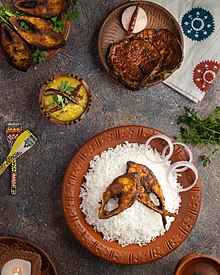


- Afghanistan: kabuli palaw[7]
- Albania: tavë kosi,[8] flia
- Algeria: couscous,[9] rechta
- Andorra: escudella i carn d'olla[10]
- Angola: moamba de galinha[11]
- Argentina: asado,[12][9] empanada,[13] matambre,[14][15][16] locro[17]
- Armenia: khorovats, harisa[18] (not to be confused with the North African pepper paste harissa)
- Australia: roast lamb,[19] meat pie,[20][21][22] pavlova,[23] Vegemite on toast[24]
- Austria: Wiener schnitzel[25]
- Azerbaijan: dolma[18]
B

- Bahamas: crack conch with rice and peas[26]
- Bahrain: kabsa[27][28]
- Bangladesh: Rice and fish (particularly ilish)[29]
- Barbados: cou-cou and flying fish[25]
- Belarus: draniki[30]
- Belgium: frites[31] (particularly served with mussels[32][9] or steak[33]), carbonade flamande,[34] waterzooi,[34] chocolate mousse[35]
- Belize: rice and beans[36]
- Bhutan: ema datshi[37]
- Bolivia: salteñas[38]
- Bosnia and Herzegovina: Bosnian pot,[39] ćevapi,[40][41] burek[42]
- Botswana: seswaa[43]
- Brazil: feijoada[44][9]
- Brunei: ambuyat[45][46]
- Bulgaria: Shopska salad,[47] banitsa[48]
- Burundi: boko boko[49]
C
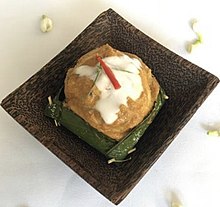

- Cambodia: fish amok,[50][51] num banhchok,[52] samlar kako[53][54]
- Cameroon: ndolé[55]
- Canada: poutine,[56][57][58] Kraft dinner,[59][dubious ] butter tarts[60][61]
- Cape Verde: cachupa
- Chile: empanada,[62] pastel de choclo,[63] marraqueta.[64][65]
- China: Peking duck,[66] crayfish[67][68] hot pot, dumpling, malaxiangguo, dim sum,[69] kaolengmian, tanghulu
- Colombia: ajiaco,[70] bandeja paisa[71]
- Comoros: Langouste a la vanille (vanilla lobster)[72]
- Democratic Republic of the Congo: poulet à la moambé[73]
- Republic of the Congo: poulet moambé[73]
- Costa Rica: casado, chifrijo (chicharrón or deep fried seasoned pork pieces served with beans, usually red or black beans), white rice and pico de gallo (it may be served with avocado and/or corn chips), gallo pinto,[9] olla de carne (stewed beef soup with a variety of vegetables).
- Croatia: zagorski štrukli[9][74]
- Cuba: ropa vieja[75][76]
- Cyprus: souvla,[77] kleftiko,[78][79] trachanás[80]
- Czech Republic: vepřo knedlo zelo (Roast pork with dumplings and sauerkraut),[81] svíčková[82]
D

- Denmark: stegt flæsk,[83][9][84] smørrebrød[85][86][84]
- Dominica: mountain chicken (historical), callaloo[87]
- Dominican Republic: La bandera (rice, beans and meat)[88]
E
- Ecuador: encebollado,[89] guatitas,[90] fanesca
- Egypt: ful medames,[91] kushari,[9] molokhiya,[92] taʿamiya[93]
- El Salvador: pupusa[94][95]
- Eritrea: zigini with injera[96]
- Estonia: kama[97]
- Ethiopia: doro wat with injera[98]
F


- Fiji: Fiji kokoda (Fijian ceviche)[99]
- Finland: rye bread,[100] karjalanpaisti, lohikeitto
- France: escargot, pot-au-feu,[101][102] beef bourguignon,[103][104] blanquette de veau,[103] steak frites,[103] baguette,[105] cassoulet,[106] cheese,[107] crêpe,[108] crème caramel,[109] poule au pot (historical) [110]
G
- Gabon: poulet nyembwe[111]
- The Gambia: domoda[112]
- Georgia: khachapuri[113][114][115]
- Germany: schnitzel, schweinshaxe, bratwurst, sauerbraten,[116] döner kebab,[117] currywurst,[118] eisbein with sauerkraut[119][120][121]
- Greece: horiatiki,[122] moussaka,[123] fasolada[124][123] souvlaki,[123] gyros,[123] magiritsa,[123] kokoretsi[123]
- Grenada: oil down[125]
- Guatemala: pepián[126]
- Guyana: pepperpot and chicken curry[127]
H

- Haiti: griot, soup joumou
- Honduras: baleada
- Hong Kong: pineapple bun, dim sum
- Hungary: goulash[102][25]
I

- Iceland: lamb,[128][129][130] hákarl[131][130][9]
- India: While India has no official national dish, khichdi is often considered one.[132][133][134][135]
- Indonesia: nasi goreng,[136][137] tumpeng,[138] satay,[136][137] soto,[136][139] rendang,[136] gado gado[136]
- Iran: abgoosht,[9] chelo kabab,[140] ghormeh sabzi[141] Fesenjan
- Iraq: masgouf,[142] dolma, Iraqi kebab, quzi
- Ireland: breakfast roll,[143] Irish stew[144][145]
- Israel: falafel (served in pita),[146][147][148][149][150] Israeli salad,[151][152] shakshouka, meorav Yerushalmi,[153] sabich, Israeli couscous
- Italy: pasta,[154][38] pizza[155][156]
- Ivory Coast: atcheke[157]
J

- Jamaica: Ackee and saltfish, jerk chicken[158]
- Japan: sushi,[159] Japanese curry,[160] ramen,[161] tempura,[162] wagashi,[163] sashimi, miso soup
- Jordan: mansaf[164][165]
K

- Kazakhstan: beshbarmak[166]
- Kenya: ugali with sukuma wiki,[167] githeri,[167] chapati,[167][168] nyama choma[169]
- Korea, North: raengmyŏn,[170] kimchi[171]
- Korea, South: kimchi,[172] bulgogi,[173] bibimbap,[174] jajangmyeon,[175][176] bingsu,[177] Tteokbokki
- Kosovo: flia[178]
- Kyrgyzstan: beshbarmak[179]
L
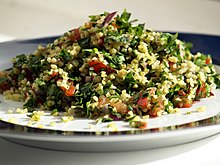
- Laos: larb/laap,[180] sticky rice,[181] tam mak hoong[182]
- Latvia: layered rye bread,[183] sklandrausis,[184] Jāņi cheese[185]
- Lebanon: kibbeh,[158] tabbouleh[186]
- Liechtenstein: käsknöpfle
- Lithuania: bigos, cepelinai,[187][188] šaltibarščiai[189]
- Luxembourg: Judd mat Gaardebounen[190]
M
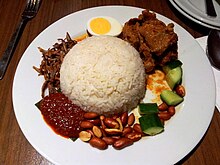
- Madagascar: romazava[191]
- Malawi: chambo with nshima[91]
- Malaysia: nasi lemak,[192] satay[193][194][195]
- Malta: stuffat tal-fenek[196]
- Mauritius: dholl puri (flatbread stuffed with lentils)[197][198]
- Mexico: taco,[9] mole poblano,[199] chiles en nogada[200]
- Monaco: barbagiuan[201]
- Montenegro: njeguški pršut
- Morocco: couscous,[9] tagine
- Myanmar: mohinga,[202] lahpet thoke[203][204][205]
N

- Nauru: coconut fish
- Nepal: dal bhat,[206] momo[206][207]
- Netherlands: stamppot,[208] soused herring with onion and pickles[209]
- New Zealand: meat pie,[210] bacon and egg pie,[211] lamb,[212] pavlova[23]
- Nicaragua: gallo pinto, nacatamal,[213] vigorón
- Niger: dambou
- Nigeria: tuwon shinkafa,[9] Jollof rice,[91][214] pounded yam and egusi soup[215][91][216]
- North Macedonia: tavče gravče[217]
- Norway: fårikål[218][219]
O
P

- Pakistan: biryani, nihari, chicken karahi, gulab jamun[221]
- Palestine: maqluba,[222] musakhan,[223] falafel[224][225]
- Panama: sancocho[9]
- Peru: ceviche[226]
- Philippines: adobo,[227][228][229][230] sinigang,[227][229] sisig,[227][231] pancit,[227][232] halo-halo[228]
- Poland: bigos,[9] pierogi,[233] kotlet schabowy,[234] Barszcz, Rosół
- Portugal: bacalhau,[235] caldo verde,[236] cozido à portuguesa,[9][237][238] Pastel de Belem, Sardinha Assada (Grilled Sardines)[239]
Q
R
- Romania: mămăligă,[241] sarmale,[242] mici[243]
- Russia: beef stroganoff, chicken Kiev, pierogi, borscht,[244] shchi,[245] Kasha,[245] pelmeni,[9] pirozhki,[246][247]
S

- San Marino: torta tre monti
- Saudi Arabia: jareesh, maqshus[248]
- Senegal: thieboudienne[9]
- Serbia: ćevapčići,[249][250][251] pljeskavica,[252] gibanica (pastry),[253] Karađorđeva steak,[254] sarma[255]
- Singapore: chilli crab,[256] Hainanese chicken rice,[257] Hokkien mee[258]
- Slovakia: pierogi, bryndzové halušky[259]
- Slovenia: buckwheat dumplings[260][261] (particularly štruklji),[262] Idrijski žlikrofi[263]
- Somalia: bariis Iskukaris
- South Africa: bobotie[264]
- Spain: tortilla de patatas[265]
- Sri Lanka: rice and curry,[270] kottu[38]
- Suriname: pom[271]
- Sweden: köttbullar,[272][9] kräftskiva,[272][273] surströmming,[274][275] ostkaka[276]
- Switzerland: fondue, muesli, raclette, rösti (core national dishes).[277] Other dishes: cervelat (national sausage),[278][9] Zürcher geschnetzeltes[279]
- Syria: kibbeh[25]
T

- Tajikistan: osh palov,[280] qurutob[280][281]
- Taiwan: beef noodle soup,[282] minced pork rice[283]
- Tanzania: chipsi mayai[284]
- Thailand: pad thai, pad gaprao, tom yum kung,[285] som tam[286]
- Trinidad and Tobago: callaloo,[127] doubles,[287] pelau,[288] bake and shark,[289] roti wrap[290]
- Tunisia: couscous,[9] brik/bric[292]
- Turkey: kuru fasulye with pilaf/pilau,[293][294] kebap,[295] baklava,[296][297] simit[298]
U

- Uganda: matooke[216]
- Ukraine: chicken Kiev, pierogi, borscht,[299][300] varenyky[301][302]
- United Arab Emirates: harees, shuwa[303]
- United Kingdom: fish and chips,[304] chicken tikka masala,[305][306]
- Cornwall: Cornish pasty[307]
- England: sunday roast[308] (especially roast beef),[309] pudding (particularly Christmas plum pudding)[310]
- Northern Ireland: Ulster fry[311]
- Scotland: haggis[312]
- Wales: cawl[313]
- United States: apple pie,[314][315] hamburger,[316][317] hot dog,[314][317] fried chicken, Salisbury steak, turkey,[317][318] mashed potatoes and gravy (historical)[319]
- Uruguay: chivito[9]
- Uzbekistan: osh[327]
V

- Vanuatu: laplap[328]
- Venezuela: pabellón criollo,[329] arepa[330]
- Vietnam: phở, hủ tiếu, bún bò Huế, bún riêu, bún chả, bún thịt nướng, mì Quảng, cơm tấm, bánh chưng, bánh giầy, bánh mì, bánh cuốn, bánh xèo, gỏi cuốn, chả giò
Y
Z
Gallery
- Chelo kabab, a national dish of Iran
- Ćevapčići, considered a national dish in several Balkan states
- Couscous, national dish of Morocco, Algeria and Tunisia
- Hainanese chicken rice, a national dish of Singapore
- Phở - Vietnamese noodle soup, considered a Vietnamese national dish
- Ndolé from Cameroon
- Russian pirozhki
- Poutine, considered one of the national dishes of Canada
- Pilaf (O'sh), a national dish in the cuisines of Central Asia
- Thieboudienne, Senegal national meal
- Ukrainian borscht
Drink
National drinks
A national drink is a distinct beverage that is strongly associated with a particular country, and can be part of their national identity and self-image. National drinks fall into two categories, alcoholic and non-alcoholic. An alcoholic national drink is sometimes a national liquor drank straight/neat (as in the case of whiskey in Ireland), but is most often a mixed drink (e.g., caipirinhas in Brazil and pisco sours in Peru and Chile), or beer or wine. Examples of non-alcoholic national drinks include tea for China, Coca-Cola for the US, lassis for India, mate for Uruguay, and kompot for East European nations.


